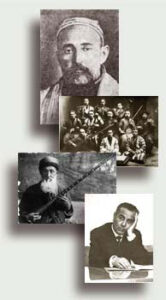SHARE WITH FRIENDS:
The art of maqom is present in the musical heritage of many peoples of the East and forms the basis of national music. Maqoms is a series of musical complexes created in a certain order, which is a unique form of composition. The status is wide
is an encyclopedia of folk music in the sense. Because in them, especially in Shashmaqom, a number of aspects based on the peculiarities of the weight of the music of the Uzbek and Tajik peoples, melodies, circle methods, the rules of connection of poetry and folk songs are fully expressed.
What is status? Maqam in Arabic means "place", "place", "space", and in the concept of music it means a place where sound is formed on musical instruments, that is, it actually means a curtain. The maqom represents the tone, which begins with a certain curtain, as well as the set of melodies and songs that correspond to them. The author of the encyclopedia "Giyosul-lug'at" Giyosuddin, based on the comments of scholars of the past, describes the phrase maqom as follows: Here, of course, the curtain where the melodies and songs begin and the fret loudspeakers in which they move are taken into account.
It is known from old sources about music that maqoms have historical-theoretical and practical aspects. Their theoretical issues are Kindi, Farobi, Khorezmi, Ibn Sino, Urmavi, who lived and worked in the IX-XV centuries; It has been interpreted on a deep scientific basis in the treatises of great scholars such as Shirazi, Maraghi, Jami and Husseini. It should be noted that the theory of music had almost the same meaning in all the peoples of the East, except for some differences. Even the names of the offices and departments were similar. However, their musical content is unique to each nation and radically different from each other.
Past musical theoretical treatises discuss the Twelve Maqom (Twelve Maqom) complex and its 24 chapters and six voices.
It is known that in the musical treatises, literary, historical and artistic sources created from the time of Timur to the XVIII century, the names of musicians and composers who worked creatively on maqoms, the melodies and songs they created, the status of the circle are given. The curtains of the twelve maqoms mentioned in the musical treatises are almost identical in shape to the six maqoms, or they are very close.
The treatises of such scholars of the XVI-XVII centuries as Najmiddin Kavkabi and Darvish Ali Changi tell about the Twelve maqams introduced during the Bukhara khanate and the artists who composed melodies based on them.
As for the attitude of the twelve maqoms to Shashmaqom, the names of their maqoms and branches are often the same. This indicates that some of the twelve statuses and divisions were merged into six statuses into a single category. Taking into account the fact that the names of the Twelve maqoms meet in the structure of the Shashmaqom, here we list the Twelve maqoms and their branches. The complex of twelve maqoms includes the following maqoms, their known forms - voice and branches: Ushshak, Navo, Busliq, Rost, Husseini, Hijazi, Rohavi, Zangula, Iraq, Isfahan, Zirafkand, Buzruk.
Votes: Navruz, Salmak, Gardonia, Gavasht, Moya, Shashnoz.
The branches of the twelve maqams are as follows: Dugoh, Segoh, Chorgoh, Panjgoh, Ashyran, Bayati, Navruz Arab, Navruz Khoro, Navruz Bayoti, Gissar, Nuhuft, Uzzal, Avj, Nayriz, Mubarka ', Rakb, Navruz Saba, Humayun, Zovuli, Isfahanak and Royi Iraq, Bastai Nigor, Nihovand, Javzi, Muhayyar.
classicmusic.uz
